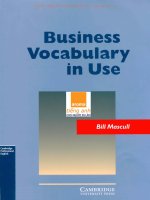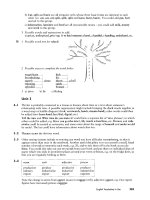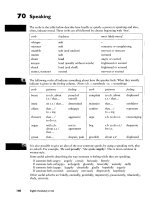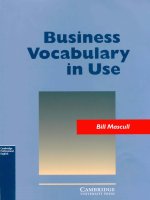Business Vocabulary in Use Advanced
Bạn đang xem bản rút gọn của tài liệu. Xem và tải ngay bản đầy đủ của tài liệu tại đây (5.98 MB, 135 trang )
Business _
Vocabulary in
Advanced
Bill Mascull
Ш CAMBRIDGE
UNIVERSITY PRESS
Contents
INTRODUCTION
QUALITY
lll^ What is quality?
THE HUMAN DIMENSION
28
A Defining quality В Quality in manufacturing C
Quality in services
World of work
10
A My work is so rewarding В I like the
team work C I want to make a contribution
Management styles
1
A Standards and cenification В ISO 9000
14
A Total quality management В Kaizen
C Just-in-time production
A Motivation 1 В Motivation 2 C Theory
X and Theory Y
Management styles
2
TQM and JIT
A Hygiene factors В Motivator factors C
Empowerment
U Employment and
employability
Quality and people
and inflexibility
30
32
34
A Investors in people В The EFQM Excellence Model
16
3 The management of change 36
A Business process re-engineering В The benefits of
BPR
A Outsourcing В Employability
C Ereelancers and portfolio workers
Flexibility
Quality standards
12
18
A Ways of working В Job flexibility C Job
protection
Work-life
balance
20
A Stress
В The causes of stress C Quality of life
9 Managing
talent
Striving for perfection
22
38
A Benchmarking and best practice В Six sigma quality
A Core competents В Creatives and suits
U Team building
24
A Teams В Team players C Stages of
team life
COMPETITIVE STRATEGY
lit^ Strategic thinking
40
A Strategy
В Companies and markets
Competition
42
A Competitors
В ‘Competing’ and ‘competitive’
Companies and their industries
44
A Competitive forces В SWOT analysis C Be good at
something
The right skills
A Hard and soft skills В
Emotional intelligence
Business Vocabulary in Use (advanced)
26
llil Key strateg
ic issues
46
A Industries and their players В Mergers and
acquisitions (M&cA) C Make or buy?
IT AND ITS USES
m The IT revolution
64
A Broadband Internet В Mobile Internet C
Moore’s Law
ЯП Innovation
48
A Innovation and the development process В Pioneers
and followers C Shakeout and consolidation
yiil Internet security
66
A Attack and defence В Cybercrime
C Privacy and confidentiality
Щ E-commerce: after boom
and bust
Preparing for the future 50
A Scenario planning В Futurology C Risk management
68
A Old economy, new economy В B2C C B2B
Knowledge
management
70
A Sharing knowledge В The learning
organization
ICM Intellectual
MARKETING
property
72
A Copyright infringement В Technical
protection C Legal protection
The four Ps and the
four Cs
52
A The four Ps В The four Cs
fff Customer satisfaction
54
A The customer В Customer delight C Customer
dissatisfaction
Knowing your customers
1
56
A Data and databases В Data mining
C Customer relationship management
m Knowing your customers
2
58
A Segmentation
В Customer groups: demographic and behavioural
segmentation C Customer groups: lifestyle and
psychographic segmentation
Brands and branding
60
A Brand equity
В Brand positioning and differentiation C Brand
stretching
Global brands
COMPANY FINANCE
icfcl Measuring performance
CD Profit and loss account
62
76
A Accruals accounting В Profit and loss C
Earnings
iCM Balance sheet 1
A Steps abroad 1 В Steps abroad 2 C Think global, act
local
74
A Financial reporting В The financial year
C Shareholders, bondholders and lenders
78
A Assets В Depreciation
Balance sheet 2
A Liabilities В Shareholders’ equity
Business Vocabulary in Use (advanced)
80
Cashflow statement
82
A Cash inflows and outflows В Types
of cashflow
investment ratios
A Return on assets В
THE GLOBAL ECONOMY
Eiri Global forces
84
Return on equity C
Leverage
Globalizing trends
Investment and debt
86
Trade
International aid
88
104
A Dismantling the barriers В Protected
industries C Fair trade
Q) Accounting standards
A Audits and their transparency В
International standards
102
A Direct investment В Borrowing
C Word combinations with ‘debt’
Shareholder value
A Yield
В Price/earnings ratio C Maximizing
shareholder value
100
A Paths to prosperity В GDPandGNI C
106
A Humanitarian aid В Development aid
C The aims of aid
Sustainable development
108
A Climate change В Sustainability C
The triple bottom line
CORPORATE RESPONSIBILITY
Ethics and business
90
A Hthical behaviour В Accountability
and transparency C Corporate social
responsibility
m Social reporting
A Social performance audits В Word
combinations with ‘social’
C Labour standards
EM Green issues
92
Index
94
A Imvironmental pollution В
Recycling
C Word combinations with ‘environmental’ D
Sustainabilirv
Corporate governance
96
A Board organization В
Separation of roles C
Rewards for success
(and failure)
m Ethical investment
A Controversial products В
Socially-responsible investment
Business Vocabulary in Use (advanced)
Answer
98
key
no
124
Cambridge International Corpus
In writing this book, extensive use has been made of business-related material from the Cambridge
International Corpus: business articles from the British and American press.
The corpus has provided valuable information on the typical patterns of business English usage,
and this has been used in compiling the language presentation material and in many of the
exercises.
The Cambridge International Corpus is a vast database of over 700 million words of real English
taken from books, newspapers, advertising, letters and emails, websites, conversations and
speeches, radio and television.
■
The Corpus helps us to get a representative picture of how English is used, both in writing and
in speech
■
It is constantly being updated so we are able to include new words in our books as soon as they
appear.
■
It contains both British and American English, which means we can analyse the differences and
produce accurate materials based on either variety of English.
■
It is ‘real’ English so we can ensure that examples in our books are natural and realistic.
Cambridge Business Corpus
The Cambridge Business Corpus, which is part of the Cambridge International Corpus,
contains business articles from the British and American press, business books, financial and
legal documents, company reports, professional and commercial texts, government reports
and product descriptions.
More choice from the world’s bestsellers />
English __
Vocabularv fai
Use
Advanced
Grammar
in Use
4U
r«lkitv
ODeil
y. Visit our dictionary website:
www.dictionary.cambridge.org
Bi/s/ness
Vocabulary in Use (advanced)
Introduction
Who is this book for?
Business Vocabulary in Use Advanced builds on the success of Business Vocabulary in Use. It is
designed to help upper-intermediate and advanced learners of business English improve their business
vocabulary. It is for people studying English before they start work and for those already working who
need English in their job.
The emphasis is on language related to today’s important, and sometimes controversial, business
issues.
You can use the book on your own for self-study, or with a teacher in the classroom, one- to-one or in
groups.
How is the book organized?
The book contains 50 two-page thematic units, in eight key business areas.
The left-hand page of each unit presents and explains new words and expressions, and the right-hand
page allows you to check and develop your understanding of them and how they are used through a
series of exercises.
There is cross-referencing between units to show connections between uses of the same word or
similar words used in different contexts.
There is an answer key at the back of the book. Most of the exercises have questions with only one
correct answer. But some of the e.xercises, including the Over to you activities at the end of each unit
(see below), are designed for discussion and/or writing about yourself and your own organization or
one you would like to work for.
Where appropriate, references at the bottom of left-hand pages give the sources (books and websites)
for the ideas under discussion.
There is also an index. This lists all the new words and phrases introduced in the book and gives the
unit numbers where they appear. The index also tells you how the words and expressions are
pronounced.
The left-hand page
This page introduces the new vocabulary and expressions for each thematic area. The presentation is
divided into a number of sections indicated by letters: A, B, C, with simple, clear titles.
As well as explanations of vocabulary, there is information about:
■ typical word combinations.
■ the grammar associated with particular vocabulary, for example the verbs that are used with
particular nouns.
There are also notes on tricky language points, such as countable and uncountable nouns, and the
differences between British and American English.
Business Vocabulary in Use (advanced)
The right-hand page
The exercises on the right-hand page give practice in using the new vocabulary and expressions
presented on the left-hand page. Sometimes the exercises concentrate on using the words and
expressions presented on the left-hand page in context. Other exercises practise the grammatical
forms of items from the left-hand page. Some units contain tables to complete, or crosswords.
'Over to you' activities
An important feature of Business Vocabulary in Use Advanced is the Over to you activity at the
end of each unit, which caters for learners who are in work as well as those who are not. The Over
to you activities give you the chance to put into practice the words and expressions in the unit in
relation to your own professional situation, studies or opinions.
Self-study learners can do this as a written activity.
In the classroom, the Over to you activities can be used as the basis for discussion with the whole
class, or in small groups with a spokesperson for each group summarizing the discussion and its
outcome for the class. The teacher can then get learners to look again at the words and
expressions that have caused difficulty. Learners can follow up by using the Over to you as a
written activity, for example as homework.
How to use the book for self-study
Find the topic you are looking for by referring to the contents page or the index. Read through the
explanations on the left-hand page of the unit. Do the exercises on the right- hand page. Check
your answers in the key. If you have made some mistakes, go back and look at the explanations
and exercise again. Note down important words and expressions in your notebook.
How to use the book in the classroom
Teachers can choose units that relate to learners’ particular needs and interests, for example areas
they have covered in course books, or that have come up in other activities. Alternatively, lessons
can contain a regular vocabulary slot, where learners look systematically at the vocabulary of
particular thematic or skills areas.
Learners can work on the units in pairs, with the teacher going round the class assisting and
advising. Teachers should get learners to think about the logical process of the exercises, pointing
out why one answer is possible and others are not.
We hope you enjoy using this book.
Business Vocabulary in Use (advanced)
World of work
My work is so rewarding
‘I work in advertising. I love my work, which is really rewarding and stimulating. Originality and
creativity are very important in this industry, of course.
No two days are the same in my job; 1 could be contacting film companies for new advertising
campaigns one day and giving client presentations the next. 1 like the client contact and I am very
much hands-on - being involved with the productive work of the agency rather than managing it.
When 1 joined the agency, 1 hit it off with my colleagues immediately and I still get on well with
them. There’s a very good rapport between us.’
I like the team work
‘I’m an aircraft engineer. I work on the research and development of new aircraft. I love putting
ideas into practice. I like working on my own, but it’s also great being part of a team. I like the
team work and the sense of achievement when we do something new. And of course, the planes
we produce are very beautiful.
Is there anything I don’t like? I dislike days when I’m chained to a desk. I don’t like admin and
paperwork - sometimes I feel I’m snowed under with it. And in a large organization like ours,
there can be a lot of red tape and bureaucracy - rigid procedures that can slow things down.’
I want to make a contribution
‘I’m a secondary school teacher. It’s a low-paid job but I want to help people and make a
contribution to society. That’s what gives me motivation. My job gives me a lot of satisfaction.
The work can be stretching, taking me to the limits of my skills and knowledge. But it’s great to
see kids developing and learning. Of course, they can be very difficult and demanding, but
sometimes we even get recognition from parents that we are doing a good job! But I don’t like
unnecessary interference - I don’t like people breathing down my neck.’
10
Business Vocabulary in Use (advanced)









